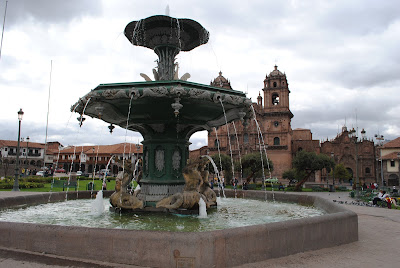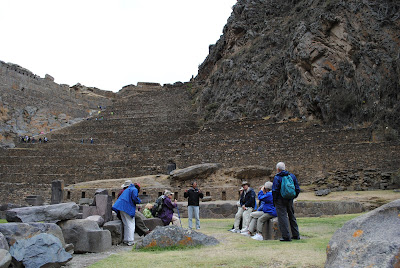| A street in Ollantaytambo |
Hiking the Inca Trail is an experience of a lifetime, to be sure, and preparing is part of the adventure. The program that I attended included three days of acclimatizing pre-hikes for the altitude and terrain of the trail. The following information will help you get ready for this exciting adventure.
*** Break in your boots well in advance of your departure. Wear your boots on the flight or pack them in your carry-on bag in case luggage is lost or delayed.***
TRAINING RECOMMENDATIONS
• Incorporate some form of cardio exercise, 45 to 60 minutes, 3 to 5 times a week for at least 8 to 12 weeks prior to your trip. We suggest running, walking, biking or a StairMaster.
• Prepare for the extreme ups and downs of the hike by training across a variety of terrains such as hills or using a treadmill incline.
• Practice yoga or some form of core strengthening exercise.
SUGGESTED PACKING LIST
• Small day pack to carry your rain gear, sunglasses, hat, sunscreen, insect repellent, camera, water bottles or hydration pack
• Hiking boots that are well worn in
• Hiking poles
• A pair of comfortable shoes, sandals or crocs to wear around the camp
• A couple of quick-dry tops and pants, socks, and underwear. Some have
suggested only 2 pair of zip-off hiking pants
• Fleece and down jacket
• Gloves and a warm hat
• Warm fleece pants for evening
• Personal toiletries, including wipes, and medications
• Camera gear with enough charged batteries for the entire hike
• Flashlight and batteries or solar equipment
LUGGAGE WEIGHT LIMIT Depending on the operator that you book with, you may be limited to no more than 8 kg/17.6 lbs (minus the weight of the sleeping bag - approx. 1.6 lb) on the Inca Trail. Professional porters will carry the bags during the Inca Trail hikes and the remaining luggage will be stored at the hotel in Cuzco, if you make such arrangements. You will not be able to access this duffel bag until you reach the evening camp so be sure that you have all that need for the day in your day pack each morning before heading out.
AVERAGE DISTANCE, WALKING TIME, AND ALTITUDE PER DAY ON THE INCA TRAIL
Day 1: Chillca - Huayllabamba Total distance: 7.8 miles Estimated walking time: 7 hours
Maximum altitude point: 9,842 feet
Day 2: Huayllabamba - Pacaymayo Total distance: 5.5 miles
Estimated walking time: 7 hours
Maximum altitude point: 13,779 feet
Day 3: Pacaymayo - Phuyupatamarka Total distance: 5 miles
Estimated walking time: 7 hours
Maximum altitude point: 12,795 feet
Day 4: Phuyupatamarka - Machu Picchu Total distance: 7 miles
Estimated walking time: 5 hours
Maximum altitude point: 11,811 feet
DEALING WITH ELEVATION
Altitude at the Inca Trail ranges from 7,790 feet to 13,780 feet.
Upon arrival at altitudes above 3,000 meters or 10,000 feet, shortness of breath and a pounding heart are normal responses to the lack of oxygen in the air. However, for some visitors, these symptoms can deteriorate into a condition known as Soroche or acute mountain sickness. Headache, extreme tiredness, nausea and loss of appetite are standard symptoms. Take it easy upon arrival and drink the coca tea provided. Oxygen is readily available for more severe reactions and is also available on the Inca Trail.
Staying hydrated and well rested is important to adjusting to the altitude. Avoiding heavy, fatty foods and alcohol in the days before arriving to altitude can also help and is highly recommended. It’s also advisable to avoid sleep medications, as they can slow breathing and respiration, which aid in getting the blood oxygenated during sleeping.
WEATHER ON THE INCA TRAIL
Months Jan Feb Mar Apr May Jun Jul Aug Sep Oct Nov Dec
Avg. Max Temp ºF 68 70 70 72 70 70 70 70 72 72 73 72
Avg. Min Temp ºF 45 45 45 40 36 34 30 34 40 43 43 45
Wet days / month 18 13 11 8 3 2 2 2 7 8 12 16
OK, it's time to start thinking about packing; waterproof jacket and pants;
gortex jacket, waterproof pants.
Water proof hiking boots; I've chosen Merrell, low profile, waterproof hiking boots. I tried on so many Trail shoes, Cross Trainers and hiking shoes but when I put these on they felt like they were made for my feet! A lot of people might choose a higher shoe and one that supports your ankle. I have high top hiking boots and I wanted to go with lower ones for more flexibility.
Socks - very important! For years I've used Smartwool and Thorlo hiking socks. Just make sure you have one pair for each day. your feet will love the fresh, new socks each day!
Loose fitting hiking pants, wicking shirts, T-shirts, fleece, hat and gloves, long underwear to sleep in or something warm, plenty of underwear and of course, sunglasses. Oh, and don't forget a water bottle or two.
The next thing to concentrate on is my DOPP kit or survival kit or whatever you want to call it with all of the necessary things you'll need for basic bodily comfort and care.
- Wipes, towelettes, etc (and a bag for trash)
- Bug spray - I'm not a big fan of Deet. I like Natrapel made with Picaridin, but there are lots of alternatives
- Wipes and hand sanitizer
- Headlamp: ever try to use the restroom with a flashlight? you'll have hands free around the camp when the sun goes down
- Toothpaste
- Q-tips, band-aids, vitamins, aspirin, Imodium, CIPRO?
- Deodorant. Many operators supply hot water "Catwash" bowls put out for each individual hiker before each meal by the porters along with some biodegradable soap to wash up.
***Some may consider water purifying tablets but you will not need them. The porters boil glacial melt water from nearby streams and purify the water with tablets. It tastes really good and is very safe, not to worry.
Remember to bring zip-lock plastic bags and enough for your trash. You know the credo, "Take Only Pictures, Leave Only Footprints".

